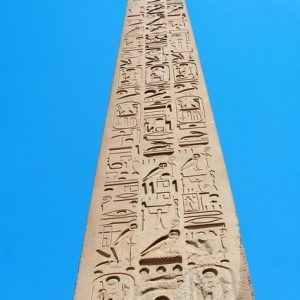During the Late Bronze Age collapse (LBA), many societies of the Mediterranean region were mercilessly attacked and crushed. Of all major powers in 1150-1200 BC, only Egypt was left standing.
However, to understand the role Ethiopia played during the LBA collapse, we have to go further back in history.
Ethiopia during the Green Sahara Era
In prehistoric times, Ethiopia served as one of the routes of exit from Africa for various world peoples. The narrow crossing at the Gulf of Aden was a major migration point in the Out of Africa migration tens of thousands of years ago.
During a period of massive climatic change around 12,500 BCE, the African Inter-Tropical Convergence Zone moved north. The result was a wetter Sahara and Southern Europe while the Great Lakes region all but dried out.
It was this climate shift that led to the most recent occupation of green Sahara by the previous dwellers of East Africa – the cradle of mankind. At this point in time, the composition of these peoples is impossible to piece together.
All we know is that Ethiopia was used as one escape route out of Africa. Another route was following the Nile river into Egypt and then on to the Levant. However, the largest body of immigrants settled in the greened Sahara.
Ethiopia at the end of Green Sahara
Unbeknown to these new settlers, this vast paradise of massive lakes, rivers, and forests was an episodic event. Between 2700 BCE and 2100 BCE, the desertification of the Sahara started in real earnest.
In 2500 BCE, Saharan populations started moving outwards, towards the Levant. By 2100 BCE, ancient Saharans were being scattered to the north (Atlas Mountains and Europe), to the south (West Africa) and to the east (Nile Valley and Egypt).
Ethiopia served as a transit point for those who sought to move from Egypt to the Kenyan highlands. But many immigrants also settled here, and contributed massively to the development of modern Ethiopia.
The rise of Axum
Shortly after the Late Bronze Age collapse in Egypt, the Kingdom of Axum started gaining prominence in the region of Ethiopia. But the people who founded this kingdom had been in Ethiopia for millennia.
They also erected obelisks over their king’s grave. The oldest still standing of these structures is dated to at least 2000 BCE. It is also smaller than the obelisks constructed by Ethiopia in its heyday, proof of the limitations that Egypt placed on the development of her southern neighbours.
But with Egypt severely weakened by the Late Bronze Age collapse, the path was clear for Ethiopia to rise. However, with Egypt gone, so was the protection her powerful armies had provided from the plundering armies of the Levant.
In 520 BCE, the Persian king Cambyses II conquered the entire land of Egypt. This blasphemous king then proceeded to destroy and desecrate many temples to Egyptian gods before proceeding further south and invading Kush. After a resounding victory there, he then had the name of kingdom’s capital changed from Saba to Meroe – his sister’s name.
Axum survived this invasion (and many others afterwards) only to be destroyed in the 10th century CE by invading Muslim forces. A few centuries later, it emerged further south as the bona-fide Kingdom of Ethiopia – later Empire.
Arwe myths and the Queen Mother of Sheba
Before the establishment of Ethiopia as a mighty kingdom, many small kingdoms had risen and crumbled in the Ethiopian highlands. Some of the more prominent include the aforementioned Axum, Saba (Sheba), D’mt, Damot, and Macrobia.
Before the foundation of all these kingdoms, the Ethiopian peoples (all who dwelled south of Egypt) had an Arwe myth. It went something like this; for 400 years, the people were ruled over by a serpent-king. This serpent-king subjugated the Ethiopians and demanded tribute from the best of their produce and resources. However, the founders of the Solomonic dynasty had destroyed this serpent-king, finally winning them their freedom.
Perhaps this myth throws some light onto the most popular Ethiopian story there is – the story of the Queen of Sheba’s visit to Solomon. But for this myth to make sense, some clarity about the underlying factors is needed.
First off, the different peoples in the region of Ethiopia practiced a matrilineal succession form of rule. In the case of Sheba, the King’s sister produced the heir to the throne of the existing king.
Secondly, the Queen Mother held real political power. She had a court and attendants, helping her to fulfill her duties as regent queen.
Thirdly, Queen Mothers were commonly known as Kandake (Candace in Greek). So for example, there are four queens named Candace from Ethiopia in modern (Greek) history.
The final point to note here is that, whoever she was, the Queen of Sheba did not just decide to visit Israel. History records that Solomon had summoned her on penalty of an Israelite attack upon Ethiopia.
Whatever the circumstances of the Queen of Sheba's visit, her son Menelik I established the Solomonic Dynasty in Ethiopia circa 10th century BCE. Descent from King Solomon would continue to influence Ethiopia’s succession politics until the 20th century.
If the Arwe serpent-kings did indeed refer to Egypt – the pharaoh’s crown was decorated with a cobra uraeus – Ethiopia made every effort to cut off ties at first. By forging such strong links with a kingdom that was opposed to Egypt from its foundation, Ethiopia was boldly forging a new path for her future.
Ethiopia’s ties to Israel continues
Ethiopia’s association with Israel did not end with the visit of Queen Sheba. Afterwards, the two powers established strong religious, trade, and political ties.
In the Book of Enoch, Israelite priests were brutally persecuted by King Manasseh. He instituted a system of idol worship in Israel and removed the monotheistic religion of the Israelite founding fathers.
Under threat of death, these priests decided to seek asylum elsewhere. They found a good home in Ethiopia, among people who had converted to a pseudo-Judaic religion that combined Israelite religious practices with their native customs and traditions.
During their migration to Ethiopia, the Israelite priests (who were the keepers of the Ark) brought the Ark of the Covenant with them. Naturally, this claim has never been proved.
But there is proof that Ethiopia converted to Christianity very early in its foundation. Aside from attestations in the Bible, numerous churches have been building all over Ethiopia, some of which are more than millennia old.
And in 330 CE, King Ezana – the reigning monarch of Ethiopia at the time – made Christianity the official religion of the empire. Ethiopia was one of the first countries in the world to formally recognize Christianity as the state religion.
While the Late Bronze Age collapse brought damnation to the established power of the time, many others were able to rise in the aftermath. Ethiopia was one of these powers that rose after the LBA collapse. In just a few centuries, she was finally able to move from the shadows of Egypt and set her own destiny.





